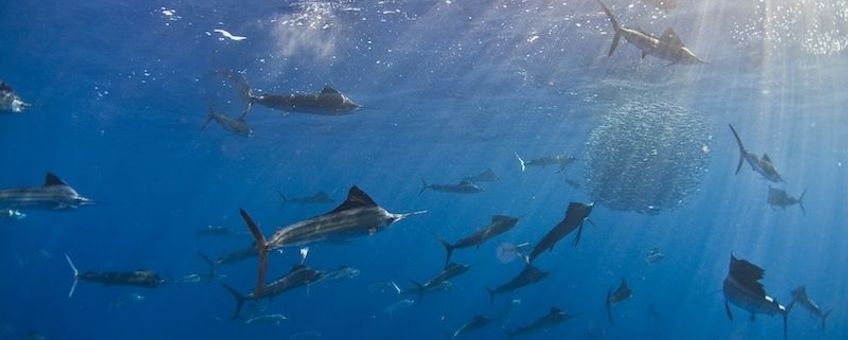
Can't see it coming: why sailfish hunt more successfully as a group
IGB BerlinThe crucial factor of their success is that sailfish always hunt in groups containing roughly the same number of individuals that attack from the right as those that attack from the left. In this way, their prey is unable to predict from which side the attack will occur.
Predators and their prey evolve together: it is vital for predators to develop effective hunting strategies, whereas the prey species is intent on evading its attackers. An international team of researchers involving IGB has investigated the predator-prey relationship between sailfish (Istiophorus platypterus) and sardines (Sardinella aurita). “When attacking, most sailfish specialise in attacks from either the left or the right, enabling them to attack more effectively,” reported Dr. Ralf Kurvers, lead author of the study.
The researcher and his team discovered that specialisation in attacking from the left or right, referred to technically as laterality, has its advantages in hunting. In fact, the more strongly an individual was lateralized, the more successful it was in capturing prey: the fish can attack very quickly with their preferred side. This is an advantage because sardines are considerably more agile than their hunters. However, sailfish are only successful predators because they hunt in groups: a single sailfish that always attacks from either the left or the right will have difficulty catching its prey, because the prey can then easily predict the side of attack.

The researchers were able to show that the key advantage of hunting in a group is that the prey species is unable to predict whether the sailfish are specialised in attacking from the left or from the right, making the predators more unpredictable to their prey. “The larger the group, the more balanced the left/right relationship is, and the more successful the sailfish will be in hunting sardines,” reported Dr. Kurvers.
In their study, the researchers analysed a total of 365 attacks by 73 sailfish, which occurred in 11 groups with up to 14 individuals per group, in the open ocean off the coast of Mexico. In a morphological analysis, the researchers also examined signs of wear in the microteeth on the long bill used by the predatory fish to attack their prey. This analysis confirmed that most fish prefer to attack from the left or from the right.
The fact that sailfish hunt in groups enables them, in evolutionary terms, to develop a very distinct specialisation. “Our study has enabled us to prove an important advantage that sailfish have when hunting in a group which, until now, was unknown,” explained Dr. Ralf Kurvers.
Incidentally, with around half of the sailfish preferring to attack from the right and the other half specialising in attacks from the left, laterality in sailfish differs from handedness in humans: some 90 per cent of the world’s population are right-handed, with only ten per cent preferring to use the left hand. “Using the same hand is useful when it comes to cooperative activities, which is why a predominant use of one hand has developed in the course of human evolution. The fact that left-handers still exist is explained by the advantages of this alternative laterality which, however, no longer plays an important role in today’s society, namely unpredictability in battle. Around half of top fencers, for example, are still left-handed, and the other half right-handed,” explained Dr. Kurvers.
The findings of this study are published in the scientific journal Current Biology.
Text: Angelina Tittmann, IGB-Berlin
Photos: Rodrigo Friscione
